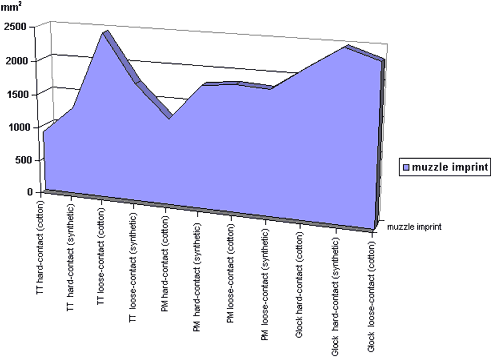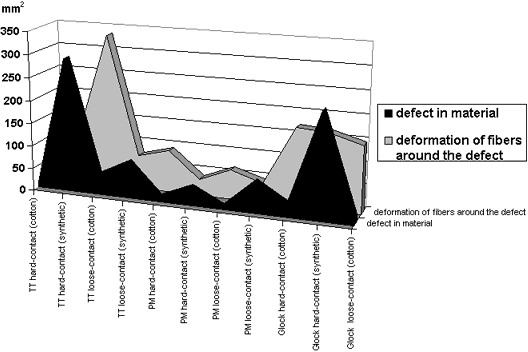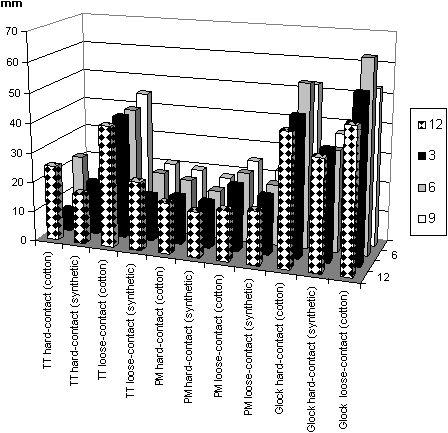
|
Медико-биологический
информационный портал
|
|
для специалистов |
|
ТОМ 4, СТ. X (сc. X) // Апрель, 2003 г.
COMPARISON OF INJURIES CAUSED BY DIFFERENT PISTOLS AT CONTACT RANGE D. Lepik, V. Vasiliev University of Tartu, Estonia Summary
Test firings were made with 7.62x25 mm Tokarev (TT), 9x18 mm Makarov (PM) and 9x19 mm Glock 19 using standard ammunition at cotton cloth, synthetic cloth and human skin. Before shooting at targets muzzle velocities of bullets fired from these pistols were measured and average velocities of bullets fired from these pistols were calculated. The most important characteristic for differentiation is muzzle imprint. TT - the main element of muzzle imprint is round-shaped. The additional element is located below it and looks like a semicircular line with a spot above the line. PM - the main element on the cloth is round-shaped and with the strongest blackening. The additional element is less visible, stripe-like and located below the main one. Glock 19 - the main element of the muzzle imprint is a bit rectangular or rhomboid due to the rectangular shape of the muzzle. The additional element below it is a semicircular line with a spot above it, but the semicircle has a bigger radius compared with the TT. In the case of loose contact the muzzle imprint may not be so typical. In addition to muzzle imprint the shape and the size of the entrance injury and the length of tears were compared. These characteristics revealed differences as well.
Introduction
On the discharge of a firearm, a large volume of incandescent gaseous material is produced. When the bullet emerges from the barrel of the gun, it is accompanied by these materials (DiMaio, 1999). As the bullet passes through any material (cloth, skin), this sooty material is deposited around an entrance hole. In contact wounds through clothing, depending on the type of fabric and amount of gas produced, tearing and/or melting of the material can occur. Contact wounds in cloth composed of cotton or cotton mixture usually result in tears with cruciform appearance. Contact wounds in 100% synthetic material result not in tears but in burn holes. The heat of gases causes the material to melt producing large circular holes with scalloped margins (DiMaio, 1999). Examination of contact bullet wounds shows the patterned imprint of the muzzle on the skin. The damage and soiling around the point of entry are the result of two factors in combination: combustion gases and the gases escaping between the skin surface and the front of the barrel (Sigrist, 1984). Such imprints may be extremely detailed, complete enough to indicate or characterise a type of weapon, and on rare occasions, a specific make or model (Mason, 1993). The more gas produced by the ammunition and weapon, the harder the skin will impact against the muzzle, and thus the greater the detail of the imprint (DiMaio, 1999). The purpose of our study was to find characteristics allowing differentiate between injuries caused by the Tokarev (TT), Makarov (PM) and Glock 19 pistols, which are the most spread pistols in Estonia.
Materials and methods
Test firings were made with these handguns and standard ammunition was used. Ammunition: TT - 7.62x25 mm 85 gr /5.5 g (manufactured in a Poland); PM - 9x18 mm 95 gr/6.1 g (Russia). Glock 19 - 9x19 mm 115 gr/7.5 g (Italy). All bullets were full-jacketed. For targets we used cotton cloth, synthetic cloth 20x30 cm and human skin (autopsy material) 6x10 cm, 10x10 cm. From each pistol 5 rounds were made at a cotton cloth and 5 rounds at a synthetic cloth. From TT - 2, PM - 7 and Glock 19 - 8 rounds at skin. For simulation of biological tissues the piece of cloth was fixed to a two-layer board (porolone and cardboard). Pieces of skin from the thigh region were obtained from young and middle-aged dead bodies not more than 12 hours after death, and then the pieces of skin were fixed to the cardboard. Before shooting at targets muzzle velocities of bullets fired from these pistols were measured by using a ballistic chronograph Model 35 Proof Chronograph manufactured by Oehler Research, Inc. (USA). And then average velocities of 10 rounds were calculated, which were following: TT 463 m/s, Glock 353 m/s, PM 324 m/s. After that firings at targets were made. After firing targets supplied with a ruler were photographed by using a digital camera OLYMPUS C-2000. Photographs were analysed by using the computer program analysis Pro. 3.0. Compared characteristics: shape and size of muzzle imprint, shape and size of the entrance injury and length of tears.
Results
In the case of contact range the most important characteristic for differentiation is muzzle imprint.
Conditionally we divided the muzzle imprint into two parts: the main and the additional element. The main element of the muzzle imprint caused by these pistols is more or less round-shaped on the cotton cloth and on the skin, but there are some differences on the synthetic cloth. The additional elements have differences in the shape, size and location. TT - the main element of the muzzle imprint on the cotton material is round-shaped. The additional element is located below it and looks like a semicircular line with a spot above the line. When the pistol was held in loose contact, the main element is bigger and the additional element is stripe-like and less separable from the main one. In a synthetic cloth we can notice a large defect of the material caused by hot gas which emerged from the muzzle of the fired weapon. The deposition of soot around the defect is round-shaped or a bit rhomb-like. The additional element is located below it and it is similar to the one on the cotton material. On the skin the shape of the muzzle imprint is less distinct due to tears. For getting a clearer muzzle imprint some extra experiments are needed. As the muzzle of PM is round-shaped it forms round-shaped imprint. There is a detail of the shape of semicircular line below the muzzle, but it is located relatively far from the front of the barrel and therefore its influence is little on the formation of the muzzle imprint. In the case of hard-contact the main element on the cloth is round-shaped and with the strongest blackening. The additional element is less visible, stripe-like and located below the main one. In the case of loose-contact the muzzle imprint may not be so typical. On the skin - round-shaped and with the strongest blackening. Glock 19 - the muzzle has a rectangular shape. There is a part below the barrel, which looks like semicircular line with a spot above it. As these details are close to muzzle, they take part in the formation of the muzzle imprint. The main element of the muzzle imprint is a bit rectangular. As the pressure of the muzzle during firing is not equal on all sides, the muzzle does not leave a strict rectangular-shape. The additional element below it is a semicircular line with a spot above it, but the semicircle has a bigger radius compared with the Tokarev pistol. Rarely the arch-like additional element above main one is notice, too. (Two our cases only). On the synthetic material the main element is rhomboid and the additional element below it is not very distinct. On the skin these elements are clearly visible. Size of the muzzle imprint. In the case of hard-contact the TT leaves the smallest and Glock the biggest imprint (result according to the total area and the area of the elements). In the case of loose-contact the total area and the area of main element of the imprint are growing bigger. The additional element becomes smaller and less distinct from the main one.
Chart 1. Size of the muzzle imprint on a cloth (results according to the total area).
Besides to the muzzle imprint other characteristics were compared.
In the case of the TT the entrance injury is round- or oval-shaped in a cotton cloth and rhomb-like in a synthetic cloth. In the case of the PM the entrance hole is round-shaped and the smallest. And Glock - the entrance hole is round-shaped, more rhomb-like in a cotton cloth and star-like in a synthetic cloth.
Chart 2. Size of the entrance injury in a cloth. In the case of Glock the tearings are the longest in both materials, maximum length in the case of loose-contact.
Chart 3. Length of tears in a cloth.
Conlusions
References
|
||||||||||||||
 Свидетельство о регистрации сетевого электронного научного издания N 077 от 29.11.2006 Свидетельство о регистрации сетевого электронного научного издания N 077 от 29.11.2006
Свидетельство о регистрации сетевого электронного научного издания Медлайн.Ру - N 227 от 20 октября 2008 года.
Выдано ФГУП "Информрегистр" Журнал основан 16 ноября 2000г.
Выдано Министерством РФ по делам печати, телерадиовещания и средств массовых коммуникаций
(c) Перепечатка материалов сайта Medline.Ru возможна только с письменного разрешения редакции
|
|
| Размещение рекламы | |
|
| |

 Articles
Articles



